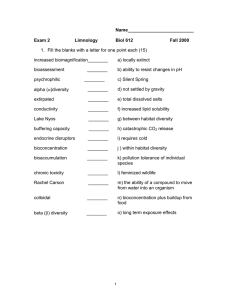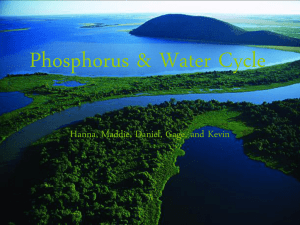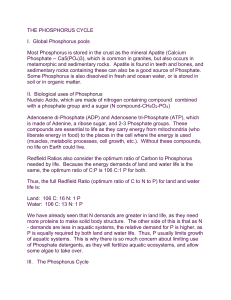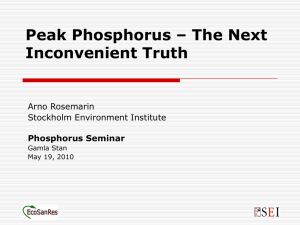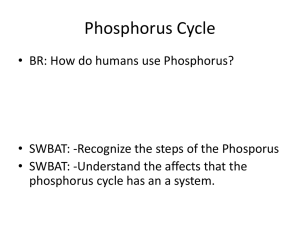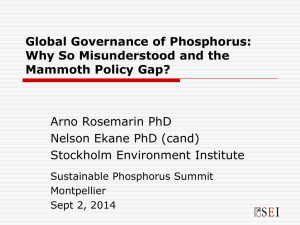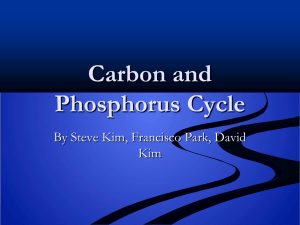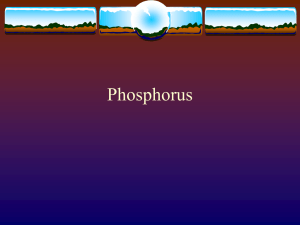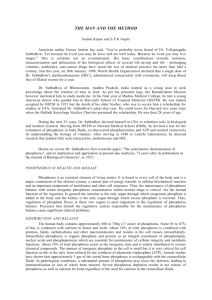Phosphorus in streams
advertisement
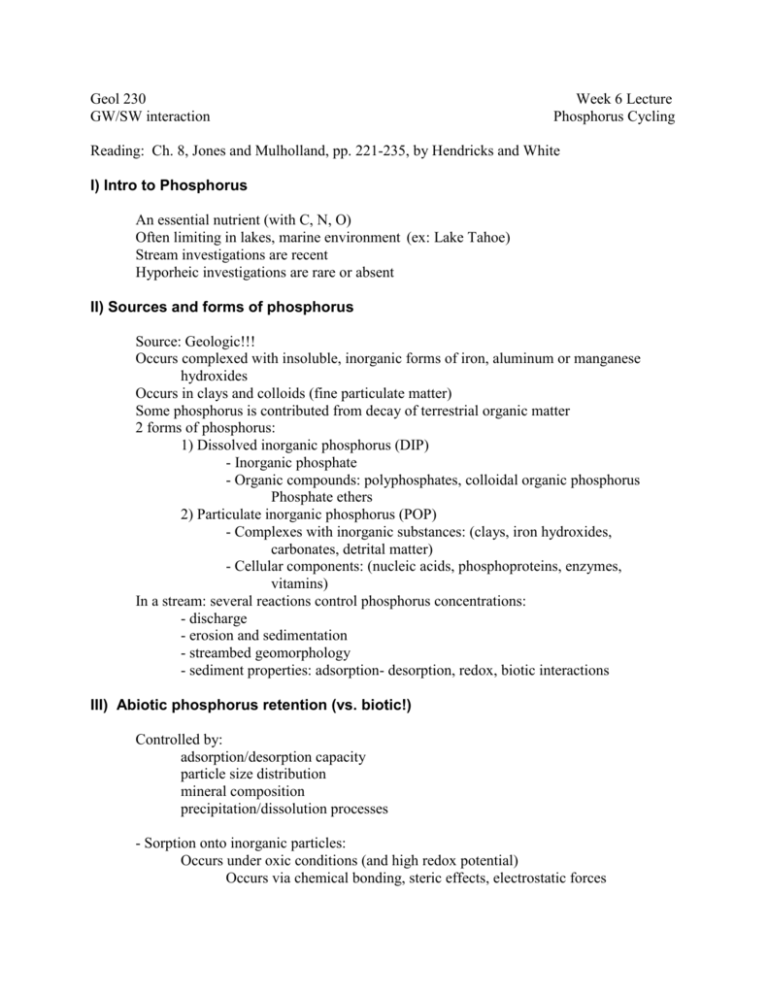
Geol 230 GW/SW interaction Week 6 Lecture Phosphorus Cycling Reading: Ch. 8, Jones and Mulholland, pp. 221-235, by Hendricks and White I) Intro to Phosphorus An essential nutrient (with C, N, O) Often limiting in lakes, marine environment (ex: Lake Tahoe) Stream investigations are recent Hyporheic investigations are rare or absent II) Sources and forms of phosphorus Source: Geologic!!! Occurs complexed with insoluble, inorganic forms of iron, aluminum or manganese hydroxides Occurs in clays and colloids (fine particulate matter) Some phosphorus is contributed from decay of terrestrial organic matter 2 forms of phosphorus: 1) Dissolved inorganic phosphorus (DIP) - Inorganic phosphate - Organic compounds: polyphosphates, colloidal organic phosphorus Phosphate ethers 2) Particulate inorganic phosphorus (POP) - Complexes with inorganic substances: (clays, iron hydroxides, carbonates, detrital matter) - Cellular components: (nucleic acids, phosphoproteins, enzymes, vitamins) In a stream: several reactions control phosphorus concentrations: - discharge - erosion and sedimentation - streambed geomorphology - sediment properties: adsorption- desorption, redox, biotic interactions III) Abiotic phosphorus retention (vs. biotic!) Controlled by: adsorption/desorption capacity particle size distribution mineral composition precipitation/dissolution processes - Sorption onto inorganic particles: Occurs under oxic conditions (and high redox potential) Occurs via chemical bonding, steric effects, electrostatic forces - Materials with affinity for phosphorus: Ferric and Al oxyhydroxides: especially important!! Calcite, aragonite Clay minerals Sediments that have pH and redox differences tend to retain iron, phosphate compounds: The interface, differences are important here Ex: low pH: sorption of phosphate to Fe, Al and clay INCREASES Stoichiometry (Fe:PO4) ratios are also important: range from 2 to 40 Ex: high pH Oxidizing environment Fe:PO4 >15 Iron absorbs most free phosphate Ex: reducing environment Fe:PO4 < 10 Iron hydroxides dissolve, phosphate is released into solution Free phosphate: can then bind to organic (humic) compounds Ex: with high Sulfate (anoxic lake, estuary or wetland environment) Lower redox potential Phosphorus desorbs (returns to solution) Hyporheic patterns are not well understood IV) Biotic phosphorus retention (vs. abiotic!) Bacteria are important Factors that control biotic retention (may be related!): Sediment properties Oxic/anoxic conditions Hydrology Microbial activity A) Aerobic microorganisms: 1) Mineralize organic matter: large, organic phosphorus molecules are transformed to soluble, bioavailable forms (phosphate) 2) Participate in Biosynthesis: inorganic phosphate is assimilated into organic matter 3) Participate in phosphorus cycling: biofilms may modify the redox environment During aerobic microbial respiration: Reduction reactions occur along a thermodynamic gradient: Terminal electron acceptor order: O2 > NO3- > Mn+4 > Fe+3 > SO4+2 > CO2 Bacteria are available for each step: Aerobes Denitrifiers Manganese and iron reducers Sulfate reducers Fermentation bacteria Methanogens This couples biologic factors (bacterial metabolism), organic matter mineralization, redox reactions, phosphorus uptake and release Generally: organic phosphorus, organic compounds are complex: Phytic acid, nucleic acids, adenosine phosphates, humic complexes “Exoenzymes” hydrolyze these compounds: acid and alkaline phosphatases, phosphodiesterase, RNase, DNase, phytase, phospholypase Exoenzymes are located: on bacterial cell surfaces dissolved in interstitial water associated with inorganic or organic surfaces High phosphatase activity indicates strong phosphorus demand by bacteria, rapid Cycling V) Fluvial dynamics and physical retention of phosphate Physical retention of phosphate is related to: Discharge Velocity Physical retention devices: Backwaters, gravel and sand bars, debris dams, woody (organic) accumulations, macrophyte beds Longer retention = more time for biotic/abiotic interaction Hyporheic zone and phosphorus: isn’t well understood Subsurface transport of phosphorus probably increases biotic/abiotic interaction Depends on oxygen content: Oxic gravels: biological and geochemical immobilization of of phosphorus dominate Anoxic fine sediments: anaerobic processes dominate Gradients of oxic to anoxic may occur under riffles or gravel bars VI) Conceptual model: surface/ subsurface exchange Model: flow under a pool/ riffle sequence Gradients form: Thermal Dissolved oxygen Biogeochemical Phosphorus is usually higher in interstitial water than in surface water See Fig. 1, p. 227 In anaerobic zones: D.O. may be inversely related to phosphorus content See J &M Fig. 2, p. 229 General model: shows the importance of redox
